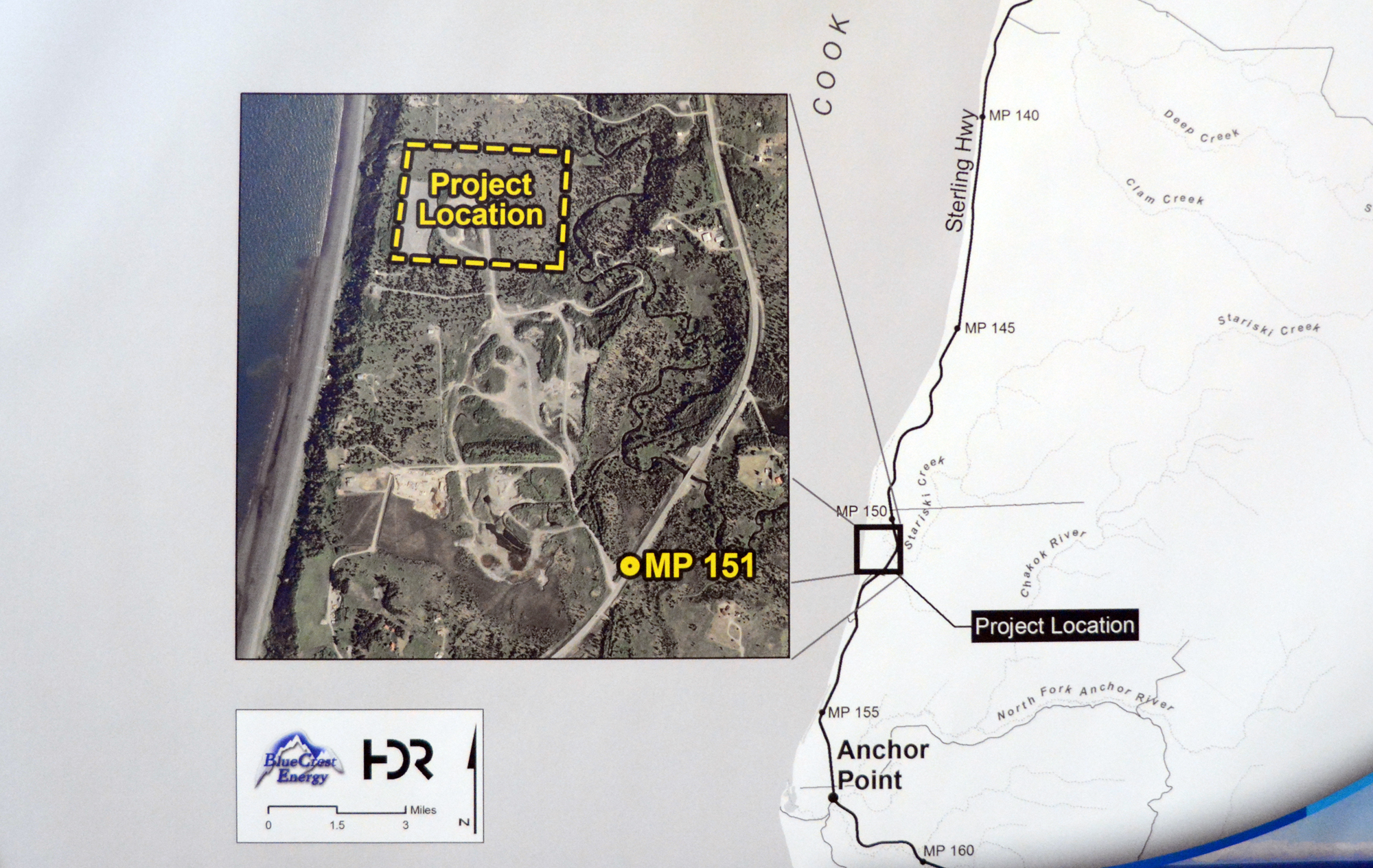Construction started this month with dirt work at the Cosmopolitan oil development project near Mile 151 Sterling Highway north of Anchor Point. At meetings in Anchor Point, Homer and Ninilchik held last week, BlueCrest energy officials briefed lower Kenai Peninsula residents on a project that may bring to fruition a decades-long dream: pumping oil out of the Cosmo prospect 2.5 miles offshore.
During construction, drilling and operations, the Cosmo could:
• Employ up to 200 workers during construction through the spring of 2016;
• Employ up to 160 workers — 80 each in two one-week shifts — during drilling starting in the winter of 2015; and
• Employ up to 60 workers — 30 in each shift — during the 30-year operations phase starting in the winter 2016.
Larry Burgess, health, safety and environmental manager for Cosmo and BlueCrest, moderated a meeting June 10 at Land’s End Resort.
BlueCrest energy is owned by three partners based in Fort Worth, Texas, including Ben Johnson, a former Anchor Point resident. BlueCrest has offices in Texas and Anchorage. When the jack-up rig Endeavour-Spirit of Independence explored the Cosmo site in 2013, BlueCrest had a 75-percent interest in the lease, with Buccaneer Oil holding a 25-percent interest. BlueCrest eventually bought out Buccaneer.
“As soon as they had their plethora of problems, BlueCrest didn’t want to have
anything to do with that,” Burgess said.
Drilling straight down into the Cosmo project proved something previous oil companies like Pennzoil, Arco, Pioneer and Conoco hadn’t been able to find in onshore drilling: beneath a cap of gas on top lurked recoverable oil. The gas had hidden the oil from seismic surveys.
“Much more oil was discovered than Pioneer or Conoco previously thought was there,” Burgess said.
With that reservoir delineated, BlueCrest plans to drill down at least 7,500 feet and then horizontally out 2.5 miles to the prospect. BlueCrest will drill 10 production wells and 10 injection wells, with plans to have oil flowing from at least one well by May 2016. At its peak it may produce up to 17,000 barrels a day of oil.
How the oil gets from the Cosmo drill site to market is one of the more controversial aspects. Burgess said there are three possible ways: pipeline, barge and truck. A pipeline wouldn’t be economical until oil hits at least $80 a barrel, but it’s the safest way. A barge would be economical, but BlueCrest’s owners don’t want to do that, Burgess said.
“They don’t under any circumstances want to put oil in the inlet,” he said.
That leaves trucking. Initially, that might be a truck a day, but could increase to two or three trucks a day. Oil would be delivered 80 miles north to the Tesoro refinery in Nikiski.
“I see that as a really weak point in the plan and potential for all sorts of problems, not just traffic problems but environmental problems,” said Michael O’Meara, at the Homer meeting.
Burgess said BlueCrest did traffic impact studies and didn’t find its level of traffic rose to the point where the Alaska Department of Transportation and Public Facilities required road mitigation.
BlueCrest does plan to put in things like truck lanes on its site. One issue would be who is responsible for oil spills from trucks. In the Lower 48, trucking firms buy the oil from a producer and then resell it to the refinery, taking responsibility during transportation. BlueCrest most likely would hire a trucking firm.
Bob Shavelson, executive director of Cook Inletkeeper, raised concerns about trucks passing over salmon streams. He wondered if BlueCrest would have strict standards in place for not traveling in adverse weather. Shavelson also asked if drilling could be shut down if roads were closed due to flooding or other disasters.
Burgess said drills could be shut down within an hour.
The tank field also would have lined containment berms to hold 110 percent of the oil from all 10 tanks combined.
“It’s very, very unlikely that any oil would get anywhere near the edge of the pad,” Burgess said.
A 14-foot-high sound and visual barrier would surround the site, an old QAP gravel pit. In response to neighbor concerns about drawing down water wells, drinking and camp water would be trucked in from Homer or Anchor Point. Lighting would be from LED lights to minimize light pollution. The site would get backup power from Homer Electric Association, but generate its own power from efficient gas turbines powered by gas found in the prospect.
Gas production also is in the plans for the Cosmo site, but not in the immediate future. If gas production is done, it would be from a monopod drilling rig offshore. Burgess showed slides comparing the Endeavour rig with its high legs to the low-profile monopod rig.
Roberta Highland, president of the Kachemak Bay Conservation Society, asked if the wells would use fracking. Burgess explained that fracking is the injection of fluid at high pressure into underground reservoirs to fracture rock and allow oil to move more freely. Fracking takes place wherever there is oil development, but it has caused problems when it’s done in shallow wells near aquifers, Burgess said.
That won’t happen at Cosmo. The wells will be 7,500 feet deep.
“It’s almost impossible to breach several layers of clay on top of that,” he said.
BlueCrest encourages local vendors to sign up and it intends to do local hire. Potential job opportunities include lodging and food services, rig crews, drilling services, health and safety services, and maintenance. For more information, visit www.bluecrestenergy.com or contact Burgess at townhall@bluecrestenergy.com or 907-754-9552.
Michael Armstrong can be reached at michael.armstrong@homernews.com.


